| Author |
Message |
Sean Flynt

|
 Posted: Thu 22 Jul, 2010 10:36 am Post subject: Pollaxe/Streithammer Project Posted: Thu 22 Jul, 2010 10:36 am Post subject: Pollaxe/Streithammer Project |
 |
|
I seem to be starting a pollaxe/streithammer/warhammer project  so I'll go ahead and start a thread as well. This piece will be using the Windlass "New War Hammer" I picked up for $62 in MRL's "Deal of the Day" bin. The photos below show approximately what I'm aiming for. so I'll go ahead and start a thread as well. This piece will be using the Windlass "New War Hammer" I picked up for $62 in MRL's "Deal of the Day" bin. The photos below show approximately what I'm aiming for.
This is an impressive single-hand hammer right out of the box if you can overlook the screws in the langets. I happen to be grateful for those because they make remounting the head on a long haft extremely simple. I tentatively tried to make this work with an old poplar dowel haft I had. That works, but not perfectly. Then I happened to notice that the hardwood handles of my wheelbarrow are exactly the length I want for the finished weapon. A trip to Lowe's yielded a thick 60" chunk of what appears to be ash--perfect for this and other poleaxe projects.
The wheelbarrow replacement handle has a section of approx. 2" square, so you can cut out of it whatever size you need as long as you have access to a table saw or planer (or have a very sharp hand plane and good stamina). I'll rip the piece almost to the right size on a table saw and switch to a hand plane and Surform tool for finishing.
I'll post more as I get into the project in coming weeks....
 Attachment: 101.94 KB Attachment: 101.94 KB

 Attachment: 210.63 KB Attachment: 210.63 KB

 Attachment: 186.36 KB Attachment: 186.36 KB
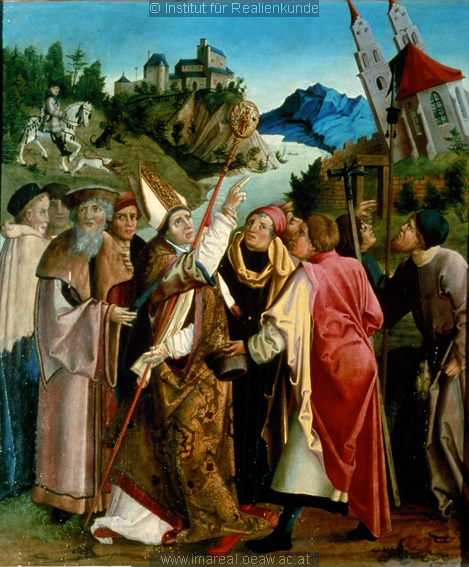
 Attachment: 164.72 KB Attachment: 164.72 KB
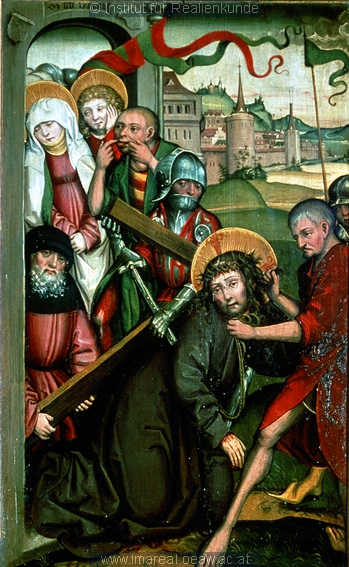
 Attachment: 110.81 KB Attachment: 110.81 KB
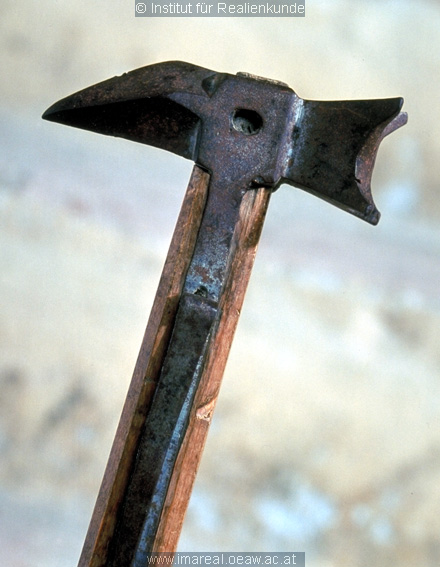
 Attachment: 171.13 KB Attachment: 171.13 KB
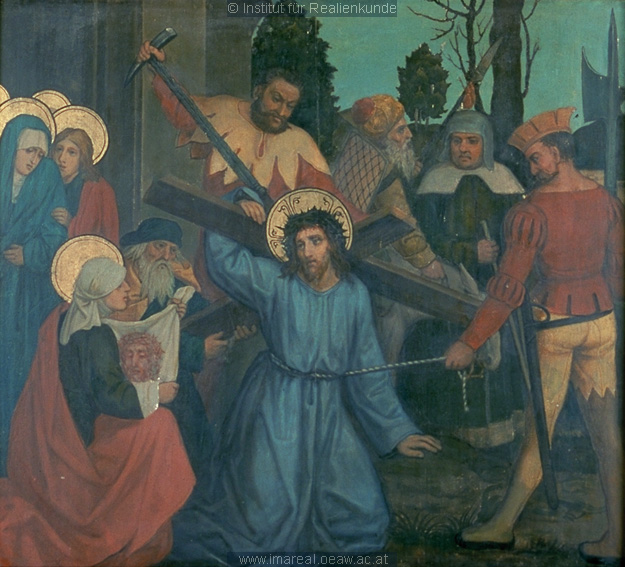
 Attachment: 177.69 KB Attachment: 177.69 KB
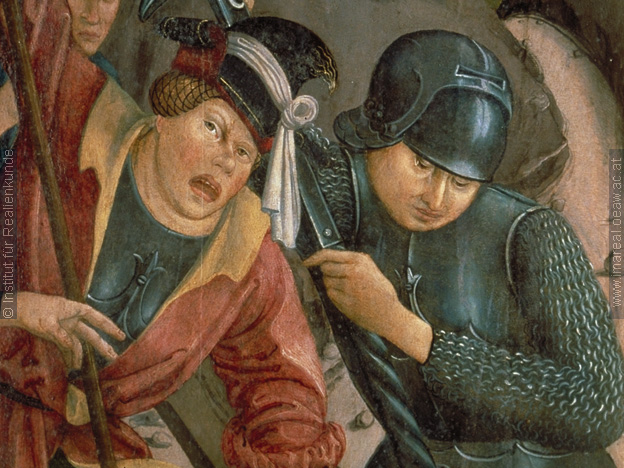
 Attachment: 195.13 KB Attachment: 195.13 KB
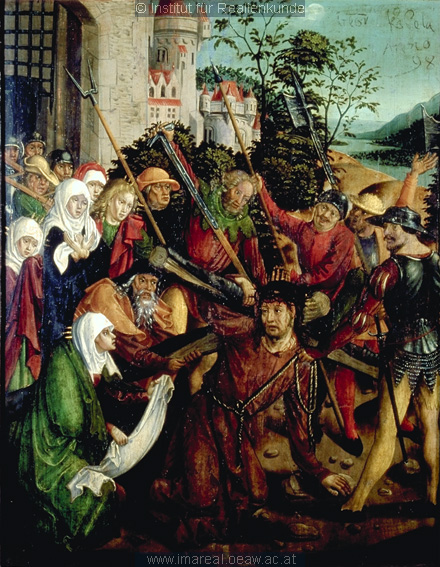
-Sean
Author of the Little Hammer novel
https://www.amazon.com/Little-Hammer-Sean-Flynt/dp/B08XN7HZ82/ref=sr_1_1?dchild=1&keywords=little+hammer+book&qid=1627482034&sr=8-1
Last edited by Sean Flynt on Thu 22 Jul, 2010 10:56 am; edited 2 times in total
|
|
   |
 |
Sean Flynt

|
|
   |
 |
Scott Hrouda

|
 Posted: Thu 22 Jul, 2010 11:03 am Post subject: Re: Pollaxe/Streithammer Project Posted: Thu 22 Jul, 2010 11:03 am Post subject: Re: Pollaxe/Streithammer Project |
 |
|
| Sean Flynt wrote: | | Then I happened to noticed that the hardwood handles of my wheelbarrow are exactly the length I want for the finished weapon. A trip to Lowe's yielded a thick 60" chunk of what appears to be ash--perfect for this and other poleaxe projects. |
Brilliant. I have a polearm head sitting in my shop AND I replaced my wheelbarrow handles this summer, but I never put two and two together.  I look forward to your results. I look forward to your results. 
...and that, my liege, is how we know the Earth to be banana shaped. - Sir Bedevere
|
|
  |
 |
Sean Flynt

|
|
   |
 |
Alex Spreier

|
 Posted: Thu 22 Jul, 2010 11:34 am Post subject: Posted: Thu 22 Jul, 2010 11:34 am Post subject: |
 |
|
Sean,
I always enjoy your projects. The end results are always beautiful, but I also enjoy the impressive amount of illustrations you provide.
As an "axe-man" I'm really excited to see how this turns out!
Alex
Compagno, Northwest Fencing Academy
http://bunkaijuju.blogspot.com/
|
|
  |
 |
Richard Schneider

|
 Posted: Thu 22 Jul, 2010 12:29 pm Post subject: Re: Pollaxe/Streithammer Project Posted: Thu 22 Jul, 2010 12:29 pm Post subject: Re: Pollaxe/Streithammer Project |
 |
|
| Scott Hrouda wrote: | | Sean Flynt wrote: | | Then I happened to noticed that the hardwood handles of my wheelbarrow are exactly the length I want for the finished weapon. A trip to Lowe's yielded a thick 60" chunk of what appears to be ash--perfect for this and other poleaxe projects. |
Brilliant. I have a polearm head sitting in my shop AND I replaced my wheelbarrow handles this summer, but I never put two and two together.  I look forward to your results. I look forward to your results.  |
That idea helps me too. I have been toying with the idea of a mace starting with a trailer hitch ball. I'm going back and forth between a steel and a wood handle. I was striking out with wood because I was looking at modern axe handles that will not work. A wheelbarrow handle is cheap, strong, and I can shape it any way I want. They're about what, two inch - two and a half inch square?
Thanks!
Last edited by Richard Schneider on Fri 23 Jul, 2010 3:12 pm; edited 1 time in total
|
|
  |
 |
Sean Flynt

|
 Posted: Thu 22 Jul, 2010 12:40 pm Post subject: Posted: Thu 22 Jul, 2010 12:40 pm Post subject: |
 |
|
Yeah, about 2". You might be better off with an ash rake handle, though, since your mace head will be symmetrical, with a round base. You'd get a lovely mace haft out of one of those. The Lowe's where I got my handle had at least eight kinds of hardwood tool hafts, from the (unsuitable) axe handles to the long ash shovel and rake handles. Some of those are very thick, and the only thing that makes them unsuitable for longer polearms is their bottle-shaped taper and round section.
-Sean
Author of the Little Hammer novel
https://www.amazon.com/Little-Hammer-Sean-Flynt/dp/B08XN7HZ82/ref=sr_1_1?dchild=1&keywords=little+hammer+book&qid=1627482034&sr=8-1
|
|
   |
 |
Christian Henry Tobler

Location: Oxford, CT Joined: 25 Aug 2003
Posts: 704
|
|
    |
 |
Jean Thibodeau

|
 Posted: Thu 22 Jul, 2010 8:05 pm Post subject: Posted: Thu 22 Jul, 2010 8:05 pm Post subject: |
 |
|
Sean;
I will have to see if I can find similar wheelbarrow handles or other types of tool handles that might make some interesting projects.
If 60"X2" I could make a very stout octagonal quarterstaff maybe tapering it a bit at the ends.
Also hand carve a walking stick leaving a 2" knob and cut in some spiral grooves in the first couple of feet near the head.
A walking staff similar to the walking stick but longer and tapering down to 3/4". ( Anyway, I like making, collecting and using walking sticks ).
Oh, back on Topic that warhammer head looks very good and with a haft upgrade and maybe some light bluing it should look really good.
You can easily give up your freedom. You have to fight hard to get it back!
Last edited by Jean Thibodeau on Fri 23 Jul, 2010 9:18 am; edited 1 time in total
|
|
  |
 |
Chad Arnow
myArmoury Team


|
 Posted: Fri 23 Jul, 2010 5:52 am Post subject: Posted: Fri 23 Jul, 2010 5:52 am Post subject: |
 |
|
A couple of folks have used the term "wheelbarrel." As far as I know, there is no such thing.  It's a wheelbarrow. It's a wheelbarrow.
Might help to ask the hardware store clerk for the right thing. 

ChadA
http://chadarnow.com/
|
|
    |
 |
Richard Schneider

|
 Posted: Fri 23 Jul, 2010 7:27 am Post subject: Posted: Fri 23 Jul, 2010 7:27 am Post subject: |
 |
|
| Chad Arnow wrote: | A couple of folks have used the term "wheelbarrel." As far as I know, there is no such thing.  It's a wheelbarrow. It's a wheelbarrow.
Might help to ask the hardware store clerk for the right thing.  |
Sorry Gov . . . tis my groundling vernacular. Damn thing is always getting in the way.
|
|
  |
 |
Jean Thibodeau

|
 Posted: Fri 23 Jul, 2010 9:21 am Post subject: Posted: Fri 23 Jul, 2010 9:21 am Post subject: |
 |
|
| Chad Arnow wrote: | A couple of folks have used the term "wheelbarrel." As far as I know, there is no such thing.  It's a wheelbarrow. It's a wheelbarrow.
Might help to ask the hardware store clerk for the right thing.  |
Just corrected/edited that and I had noticed the error yesterday, as my spell check had showed the proper word, but I guess I didn't " click " the change button but I was really sure that I had.  
You can easily give up your freedom. You have to fight hard to get it back!
|
|
  |
 |
|
Josh MacNeil
Location: Massachusetts, USA Joined: 23 Jul 2008
Posts: 197
|
 Posted: Sat 24 Jul, 2010 10:42 am Post subject: Posted: Sat 24 Jul, 2010 10:42 am Post subject: |
 |
|
|
Sean - I redid one of these myself a few months back. I'm looking forward to seeing how your adventure turns out!
|
|
   |
 |
Scott Hrouda

|
 Posted: Mon 02 Aug, 2010 7:11 am Post subject: Posted: Mon 02 Aug, 2010 7:11 am Post subject: |
 |
|
Sean,
What are your thoughts on pole size (not length) and cross section type? Does 1 1/4" to 1 1/2" sound reasonable and historically accurate? I suppose poles had round, square, rectangular and hexagonal cross sections depending on the wishes of the end user. Do you know of any resources that list type of cross section and size of existing historical pieces?
...and that, my liege, is how we know the Earth to be banana shaped. - Sir Bedevere
|
|
  |
 |
Sean Flynt

|
 Posted: Mon 02 Aug, 2010 7:54 am Post subject: Posted: Mon 02 Aug, 2010 7:54 am Post subject: |
 |
|
| Scott Hrouda wrote: | Sean,
What are your thoughts on pole size (not length) and cross section type? Does 1 1/4" to 1 1/2" sound reasonable and historically accurate? I suppose poles had round, square, rectangular and hexagonal cross sections depending on the wishes of the end user. Do you know of any resources that list type of cross section and size of existing historical pieces? |
This is the bible:
Waldman, John: Hafted Weapons in Medieval and Renaissance Europe: The Evolution of European Staff Weapons between 1200 and 1650
http://www.myArmoury.com/talk/viewtopic.php?t...ht=waldman
It has everything I can think of, including extensive information on hafting.
Hafts are often depicted as surprisingly flimsy-looking, and this isn't easily dismissed as artistic misrepresentation. In the illuminations for Froissart's Chronicles, one often sees bending hafts. The pollaxe hafts in the 1467 version of Talhoffer's treatise on that weapon also shows thin hafts. There doesn't appear to be much room for interpretation here--too thin and the haft will break, too fat and one can't get a secure grip. What feels secure in my hand might not feel the same in somebody else's, but I'd say 1.25" is in the right range, assuming we're talking about an octagonal section.
One very important thing to keep in mind, though, is that the section tends to vary along the length of the haft. It's an overlooked aspect of hafting but it makes sense for lots of reasons. You can see many examples of staff weapons with an almost square section (very slightly octagonal) just under the head and for the length of the langets, with the haft becoming more strongly octagonal below. Also, the halberds I've seen up-close and full-length at the Wallace Collection show pronounced tapering from head to foot, while the pollaxes in the same collection appear to be of more uniform section. It looks to me like maybe the great heaps of late halberds in the Graz Landezeughaus have more uniform section as well.
I have a theory about this. If you're hafting massive numbers of halberds, you need to harvest the ash as soon as you have a stout enough section. If you wait through enough growing seasons to get a trunk large enough at its small end to suit a halberd head, you'll be waiting much longer than if you harvest based on the thickness of the base of the tree. You simply mount the head on the thick end, which also saves wood because you need to plane, straighten and facet the grip. If you leave the fat end at the foot, you'll have to throw away all of that extra wood. The fat-end-up theory also serves balance and security for the head. It's just a theory. If you're hafting massive numbers of halberds, you need to harvest the ash as soon as you have a stout enough section. If you wait through enough growing seasons to get a trunk large enough at its small end to suit a halberd head, you'll be waiting much longer than if you harvest based on the thickness of the base of the tree. You simply mount the head on the thick end, which also saves wood because you need to plane, straighten and facet the grip. If you leave the fat end at the foot, you'll have to throw away all of that extra wood. The fat-end-up theory also serves balance and security for the head. It's just a theory.
As far as I can tell, perfectly round and square sections are rare. It's difficult to orient the former and difficult to hold the latter unless the haft is very narrow. Octagonal--whether slight or pronounced--appears to be the most common section for all staff weapons. It improves the grip, helps orient the blade and allows for both a comfortable grip and a stout haft.
Pollaxes tend to be in the range of chest to top-of-head. Halberds start in the same range and can get quite high (8'?), judging from period artwork. Robust hunting and combat spears appear to be in the 6-8' range. Two-hand hammers are typically shown in the hip-to-chest range.
Before the early 16th c., langets were commonly attached by nails. Riveting langets doesn't appear to be appropriate before 1500, and probably a bit later. I assume that's because it weakens the haft more than nailing. Waldman has some very enlightening X-rays!
So, here's where I am in my project. As of this morning I have a slightly tapering, strongly octagonal haft of approx. 52", with a notably more robust and square section for the full length of the langets. This gives an overall weapon length of approx. 57", including the heavy steel foot from the original short haft. Still left to do: fitting the foot, faceting the foot to match the haft, sanding the haft, treating with boiled linseed oil, rounding the ends of the langets, filing the hammer marks from the top spike (due to slight straightening) mount and secure langets with nails. It'd be much easier just to rivet the langets because the holes align perfectly, but having gone to the trouble of making an historically correct ash haft, I'd like to finish the thing properly.
-Sean
Author of the Little Hammer novel
https://www.amazon.com/Little-Hammer-Sean-Flynt/dp/B08XN7HZ82/ref=sr_1_1?dchild=1&keywords=little+hammer+book&qid=1627482034&sr=8-1
|
|
   |
 |
Scott Hrouda

|
 Posted: Mon 02 Aug, 2010 4:58 pm Post subject: Posted: Mon 02 Aug, 2010 4:58 pm Post subject: |
 |
|
| Sean Flynt wrote: | This is the bible:
Waldman, John: Hafted Weapons in Medieval and Renaissance Europe: The Evolution of European Staff Weapons between 1200 and 1650 |
This book has been added to my myArmoury wish list! I'll have to wait as I've recently exceeded my book budget thanks to Nathan's and Chad's reviews of 2,500 years of European helmets, 800 B.C.-1700 A.D. 
The information you posted was most helpful. If I understand everything correctly, my (admittedly cheap) gdfb poleaxe head could be mounted on an octagonal shaft 1.25" in diameter. This shaft shape will transfer to an almost square cross section at the langets and continue thus to the head. The langets should be secured with nails. The total length will be about 68", just a few inches short of my height out of armour. For extra hand carving fun I can also inset the langets into the shaft.
Does this sound correct?
...and that, my liege, is how we know the Earth to be banana shaped. - Sir Bedevere
|
|
  |
 |
Sean Flynt

|
|
   |
 |
Sean Flynt

|
 Posted: Mon 02 Aug, 2010 8:10 pm Post subject: Posted: Mon 02 Aug, 2010 8:10 pm Post subject: |
 |
|
Here's more detail on halberd hafts, now that I can sit down with Waldman. Where this conflicts with my earlier observations, I certainly defer to Waldman as he clearly has been busy with his calipers (hard to spot a 2-3 mm difference without `em).
most original hafts are 5-6'
"the oldest (round) shafts measure 4cm in diameter and the 15th and 16th c. rectangular or square shafts with shaved corners (octagonalized), are usually 3.3 to 3.8 cm in diameter. There was also standardization in the shaping of shafts; their mid portions are the thickest; the bottoms and tops are slightly smaller (by 2-3 mm). The reason for this is not yet evident but it does not appear to be from wear as the edges and angles of the bottom of the shafts are sharp."
I also notice that I forgot to mention rectangular halberd sections earlier. Artwork seems to show these but it's not clear if they're true rectangles or slightly octagonalized. In any case, your pollaxe should be octagonal.
-Sean
Author of the Little Hammer novel
https://www.amazon.com/Little-Hammer-Sean-Flynt/dp/B08XN7HZ82/ref=sr_1_1?dchild=1&keywords=little+hammer+book&qid=1627482034&sr=8-1
|
|
   |
 |
Sean Flynt

|
|
   |
 |
Scott Hrouda

|
 Posted: Tue 03 Aug, 2010 2:57 pm Post subject: Posted: Tue 03 Aug, 2010 2:57 pm Post subject: |
 |
|
| Sean Flynt wrote: | | This example from the Wallace Collection shows nice hafting details. This is very much like what I'm doing with my hammer haft, though I've shaved the edges in the upper section more than shown here. How do you like that GDFB head, Scott? I might need to get one of those now that I have a source for good ash hafts. |
The GDFB piece should be considered a good project piece, especially for the price. Once hafted, it would look similar to the Wallace Collection piece you posted, less the stop-guard. The two langets are welded on in a rather sloppy fashion which will require some hand filing. The hammer head has a simple checkerboard face instead of little pyramids. I think there's enough material to work the grooves with a triangular file to get the right effect. If I get really creative, I’ll manufacture a stop-guard. My guess is that a well-finished project would:
- Wow the ren-crowd at 1'
- Look plenty good for the SCA crowd at 10' (my goal)
- Grudgingly pass the myArmoury crowd at 25'
Look around a little for a good price. I only paid $37 USD plus $14 shipping and handling. I'm not too worried about screwing up the piece when I get to it.
...and that, my liege, is how we know the Earth to be banana shaped. - Sir Bedevere
|
|
  |
 |
|
|

